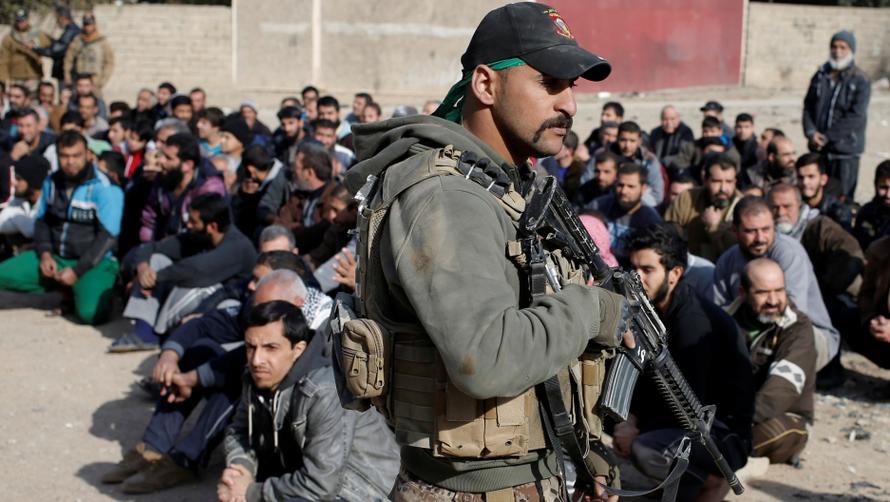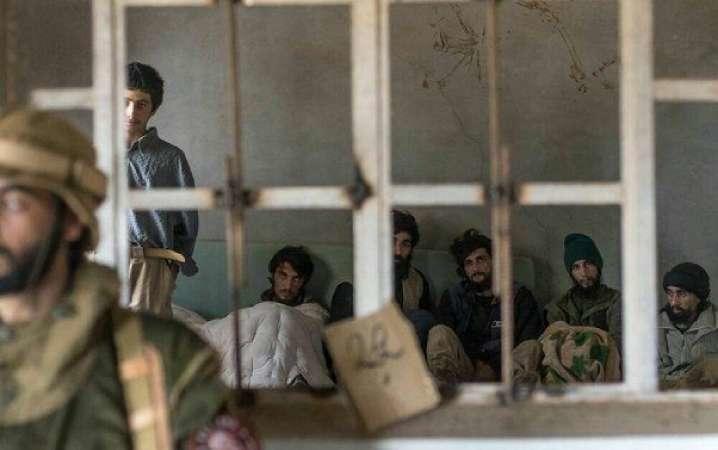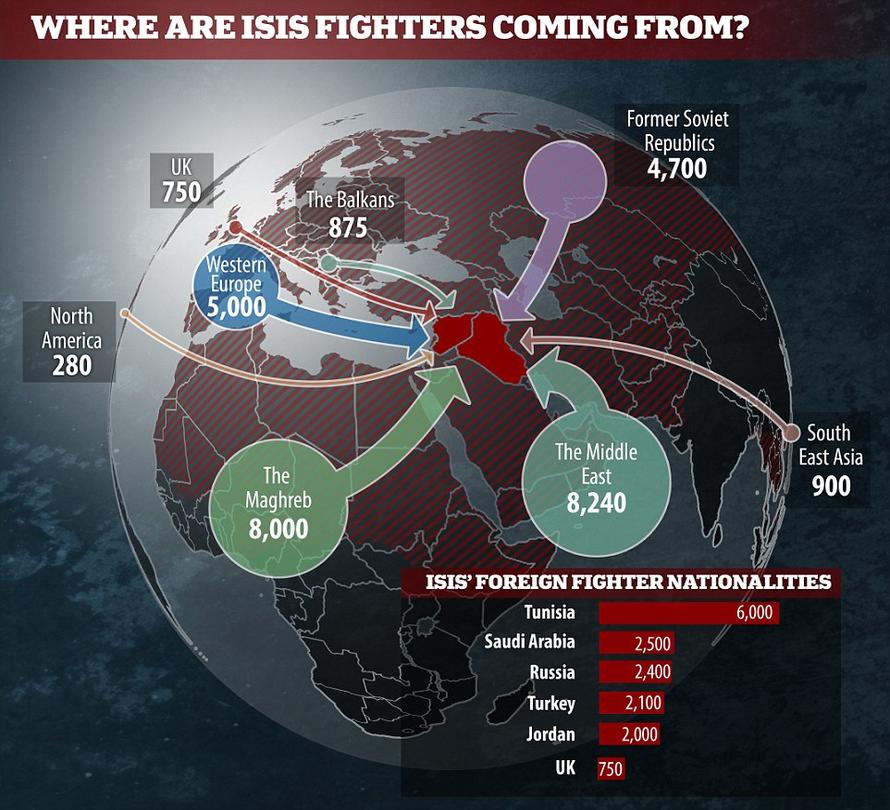Authored by Elijah Magnier, Middle East based chief international war correspondent for Al Rai Media
On Twitter, apparently the US president’s preferred forum to reveal foreign policy and state decisions, Donald Trump asked “Britain, France, Germany and other European allies to take back over 800 ISIS captured in Syria” from 44 countries. Otherwise, Trump will “release them” without specifying where and in which country. The US President is no longer ready to spend time waiting “for others (EU countries) to do their job”.
This is what the US establishment’s foreign policy and relationship with allies are all about. The US asked European, Canadian, Australian and Middle Eastern countries to send troops to Syria to “fight ISIS”. But before that, some years ago, the US asked European countries to allow potential jihadists to travel to Syria and Iraq, and for Saudi Arabia and Jordan to open their prisons and pardon core jihadists in order to reach their favorite destination, the Levant, to destroy the Syrian state and create a “failed state” scenario.

But their wishes did not come true and President Bashar al-Assad didn’t fall in 3 to 6 months as predicted in 2011. Today the world is facing a new puzzle: what should be done with those the West helped reach Syria in order to terrorize, rape, and murder the people of Syria, who now want to return to their countries of origin? It is obvious the US establishment is unwilling to help Europe deal with their human refuse who joined ISIS at America’s request.
Up to now thousands of ISIS members have managed to return to Europe and much more to their Middle Eastern, Asian and African countries of origin. These are fighters, few formerly incarcerated in their countries of origin, who answered the call and reached Syria and Iraq with the help of western and allied intelligence services to wage jihad and join the Caliphate of an “Islamic State”.
They traveled to the Levant for various reasons: to join a family member, to join friends, love of adventure, the adrenaline of carrying weapons and killing, to find one or several wives, to belong to a friendlier and warmer society (in the Middle East, society and family gatherings are closer and warmer than in Europe). Very few knew much about Islam before reaching their destination and fewer still had detailed knowledge of Islamic teaching, Hadith and Islamic laws. But one thing many of these have in common: they have killed thousands of Iraqi and Syrians.
Europe and Middle Eastern countries facilitated “jihadi-corridors” to Syria, mainly via Turkey whose authorities welcomes Jihadi immigration. Ankara’s airport had special corridors to accommodate newly arriving fighters and send them eastwards. The objective was to divide Syria and Iraq.
The world looked on impassively as ISIS gathered substantial financial resources. ISIS robbed hundreds of millions of dollars from banks in cash and gold. It was selling oil, infrastructure and handcrafts to Turkey and collecting huge sums monthly from local taxes on services, housing, electricity, agriculture, cars crossing, merchandise exchange and other sources which brought a huge income to the area under its control.
Flow of foreign fighters into Syria at the height of the Islamic State’s power (2015), via The Daily Mail.
President Barack Obama had the “courage” to say he wanted to avoid polluting the air over Syria and Iraq by bombing ISIS oil tankers. From 2014-2015 the US allegedly fought ISIS in Syria while the territory under its command continuously expanded and flourished. It required Russian intervention beginning in September 2015 to destroy those tanker trucks, thereby reducing the flow of stolen oil to Turkey and diminishing ISIS oil-income.
It is very possible that ISIS leader Abu Bakr al-Baghdadi followed Saddam Hussein’s example in hiding away financial resources and weapons for dark days. Iraqi intelligence services believe ISIS has established many civilian businesses to keep cash flowing in order to finance insurgency and continue recruitment. According to Iraqi security sources, the Iraqi Intelligence Unit arrested tens of ISIS-linked cells running wealth of hundreds of million dollars to the benefit of the group.
ISIS is also present in many caves and locations in the desert linking Syria and Iraq. Tens of less spectacular but significant attacks and assassinations are conducted every month in the provinces of Salahuddin, Nineveh, Diyala, Kirkuk and Hamrin-Makhol mountains causing the death of tens of Iraqi. For example, ISIS kidnapped this month 19 Iraqis along the Saudi and the Iraqi borders (‘Ar’ar to Nekheyb) in al-Anbar desert. Six bodies have been discovered so far.
Indeed, ISIS now needs to carry out as many terrorist attacks as possible to show it is still alive and capable. It would not be surprising to witness many insurgent attacks in the Middle East even after ISIS loses all its territory.
But the ISIS insurgency is not far from Europe, where any attack can bring more publicity to the group and help boost its propaganda efforts. The Paris and Brussels attacks (to name a couple) gave a colossal sense of power to ISIS fanboys. These attacks were planned by ISIS command in Raqqa.

Thus, the return of hundreds of ISIS militants to Europe will create a real dilemma for the same European leaders who may have been behind sending these terrorist candidates to the Levant in the first place, most of whom became prolific killers in Syria and Iraq. Many were also killed in terrorist attacks but those who remain are those who have best learned how to conduct warfare and brutal killing.
ISIS has been defeated and the circumstances that allowed it to grow in 2014 are no longer present. Many are surrendering now in their last stronghold in Syria. Nevertheless, the disappearance of ISIS territory doesn’t mean the group will no longer be present in the Middle East, Europe and the rest of the world (mainly in West Africa, Libya, Iraq, Egypt, Yemen, Afghanistan and Philippines).
Trump is throwing a ball of fire at Europe when he asks European countries to take back their nationals, indicating he is not willing to deliver ISIS prisoners to the Syrian government. There are no adequate prisons in Europe capable of holding such recruits, no means of “deradicalizing” or altering the brain-washing these Europeans have been exposed to. There is no guarantee that ISIS arrested militants will refrain from spreading their ideology and skills to become sleeper cells reading to strike at the first opportunity.
There are ways to confront ISIS ideology by using the same tools ISIS has used. Its creed can be condemned intellectually and religiously by Islamic religious authorities. The group has been contested by the Sunni religious Ulema who criticized its rationalizations and its self-declared state. Al-Qaeda is also vulnerable to such ideological attack. But how effective such criticism will be is open to question.
Although the French Security Minister Christophe Castaner welcomes ISIS militants to return to France, most European countries would rather reject their human refuse.
They lack the resources and expertise to deal with ISIS militants willing to return home. Heiko Maas, the German Foreign Minister, commented on Trump’s tweet that “it is not as easy as they think in America”. The European authorities should learn from the Syrian and Iraqi governments how to fight ISIS; otherwise, they will find it difficult to stand up to and prevent the expansion of this cancer.
via ZeroHedge News https://ift.tt/2tyxfj0 Tyler Durden
